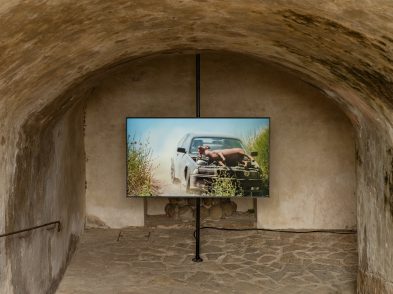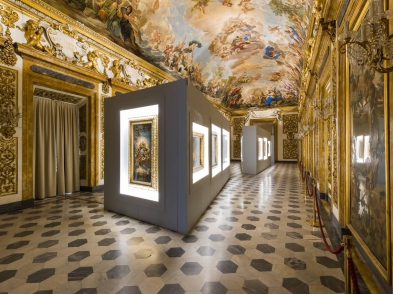For more
than a century, Villa Romana has been the Florence base for artists visiting
from Germany. Often still early in their careers, these artists are recipients
of the Villa’s annual fellowship, the Premio. From their creative presence
comes the atmosphere of experiment, production and imaginative reserve that
pervades the nineteenth-century hillside mansion on via Senese. Many observers
now regard the Villa as the most informative venue in Florence for advanced, new
international visual art. Its public gallery organises regular exhibitions and
the current show brings together four artists from Italy, Germany and Denmark
who respond, through installation, film and collage, to the enquiring spirit
that animates work by Ketty La Rocca, the quietly influential Florentine artist
who died in 1976 at age 37. As TF discovered on meeting Villa director Angelika
Stepken, the exchange between artists from different backgrounds is key to the
Villa’s role.
How did Villa
Romana become a German cultural institute?
Around 1900,
knowledge of Italy was still considered as essential to training artists
because of its classical tradition. New national states like Germany
established academies in this country but, at the same time, a movement among
artists developed to organise their activities separate from the state system.
Villa Romana is a product of that second course. It was set up in 1905 by
artists, chief among them was Max Klinger. With help from private supporters,
he bought the Villa to create a house that artists could visit in order to work
in these special surroundings.
Is it still a
private foundation?
Yes, but one
that is open to the public. The Villa has been fortunate to have received
support from the Deutsche Bank since the 1920s. The German federal government
gives funds and Siemens is sponsoring our music programme for three years. In
the past, it was quite a private place with few public events and lively
parties. Now the Villa has regular opening hours with free admission. There is
usually a show to see, and often a concert or another arts event to attend.
You arrived at
Villa Romana in November 2006. What was the attraction for you of it?
The
opportunity to bring about a fresh start. My predecessor had been director for
34 years and the role of the Villa had become quite undefined. Also, a house
for artists is a special place. I like to talk to artists, to watch and ask
questions, so this appointment appealed to me. Villa Romana gives a social
setting to art but, above all, production and reflection come first; everything
else follows.
What is your
background? You grew up in Germany.
I come from
the city of Moers, near Düsseldorf. When I was 18, I left for Berlin to study
art history, philosophy and political science at the Free University. But
before I could complete my degree I’d started writing about art for the city’s
evening newspaper. So I became an art critic and reportage journalist, and
after two years, went freelance. I liked the position: I discovered
contemporary art and how to pose questions. However, before the Wall came down
West Berlin was a small, slow city compared to today’s vibrant capital.
You worked in
German museums before coming to Italy?
Yes, but
before that I worked as an independent curator, organising my first exhibition
in 1987. As well as Germany, I’ve worked in China, Turkey and Scandinavia. In
Lodz in Poland, I put together a show that looked at the relevance of western
artistic traditions in the wake of that country’s recent experience of
communism. I had avoided on purpose working within institutions and opened my
own space. I called it a ‘museum’-ironically as it was tiny, only 18 square
meters. Its theme was to make visible the process of creating exhibitions, and
it allowed artists and visitors to examine ideas of what a museum could be.
Then you became
a museum director. What had changed?
With
unification, state support for the arts declined and a freelance existence
became precarious. I decided to try my approach, which encourages discussion,
in a public gallery. So, for eight years from 1998, I was director of a
beautiful, classical space, the Badische Kunstverein in Karlsruhe. We worked
with artists from Germany and abroad on one-person and ambitious thematic
exhibitions. For example, we introduced a year-long project, divided into what
we called ‘chapters,’ that asked about the impact artistic experimentation had
on the changed social dynamic accompanying the new spirit of capitalism after
1968.
The Villa’s
activity has always been centred on the Premio. Past winners include major
figures in the last century’s avant-garde, such as Max Beckman, Käthe Kollwitz,
Georg Baselitz and Martin Kippenberger. Today the prize is no longer restricted
to German artists?
The artists considered
for the Premio must live in Germany, but they can be any nationality. The
quality of their work is paramount. A jury comprising an artist and a curator
or writer proposes artists who can do well in this environment. Together we
discuss the candidates and award four fellowships each year. The artists stay
for 10 months, receiving a stipend, accommodation and a studio. An exhibition
introduces them when they arrive but after that we make no particular
requirement. Instead, we offer them time, which is increasingly rare in today’s
fast-moving art world. Time to work, reflect, meet interesting people and make
discoveries.
Is Florence a
sympathetic setting for contemporary artists?
It is a
challenge, which artists accept in different ways. All talk about the encounter
with history; it is ever-present but individual responses vary greatly. Artists
can engage with the city or not. After all, Florence is not only its museums
but also about tourism, interesting science and education. It provides a good base
for moving around Italy, to tap into its mood, history and Mediterranean
culture. There is a reason for being in this highly informed region that is not
confined to Florence.
The annual
fellows are not the only artists invited to the Villa.
Guest artists
also visit for two or three months, from locations outside northern Europe,
such as Tirana, Beirut and Cairo. This is an aspect I want to develop. At the
Villa, artists with different backgrounds and heritage mix together, making
some very promising exchanges and connections. In this way, Florence can be a
meeting point between Germans and artists from the southern and southeastern
Mediterranean.
Is this
encounter between cultures echoed by the exhibition programme?
Our
exhibitions communicate with the public while the fellowships are naturally
more private. But the two are often linked. Eleni Kamma, a guest artist in
2010-11, returns this year with an exhibition examining spectacle and
speculation. Our shows often look at Italian figures or locations through the
eyes of a foreign artist. Last year, Singapore artist Ming Wong, who works in
Berlin, showed his film inspired by Pasolini’s movie Theorem, while Aglaia Konrad focused her project on Carrara’s
marble quarry. Later this year we will show Albanian artists and magical
paintings by German and Polish artists responding to the Renaissance master,
Pontormo. As you can see, the scope of exhibitions is wide, geographically and
technically, and we try to link up different levels of reality in Florence or
deal with its history and future.
You recently
added to the original building.
We needed a
place to talk and think. Although the Villa has 40 rooms, there was no open
space for a lecture or concert. The solution to both budgetary and building
restrictions was a pavilion located among the cypress, olive and fruit trees in
the 1.5 hectare garden surrounding the house. A generous private donation
enabled us to commission Avatar, a young Florentine architectural practice.
Their imaginative design is ecology-based, using ordinary wood pallets for the
wall structure. Because we work with theatre, film and music as well as
artists, and because the arts today are not limited to categories, the pavilion
provides a good platform for performers and audiences to interrelate.
What
differences do you see between the art worlds of Germany and Italy?
By
comparison with Germany, it is harder to interpret the priorities of the
Italian art system; communication is on a more private level. Galleries come
and go and cultural politics do not take a long view, which can cause problems
for artists and those who work with them. There are certainly advantages in not
having the overdeveloped institutions common elsewhere in Europe and America,
but certain structures are needed. These are absent in Italy, where
responsibility for the public and an interest in its welfare and space are not
central to the system. This attitude extends through many relationships because
personal interest is on a different level than in Germany.






